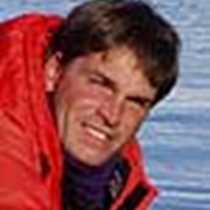Palouse River and Palouse Falls
We were treated to a beautiful sunrise this morning as we arrived at our anchorage at the mouth of the Palouse River. After a hearty breakfast and a briefing about the Zodiacs, we headed off for our various activities. The kayakers enjoyed the calm waters of the early morning as they paddled up a beautiful canyon. The reflections in the still water were amazing as the kayakers paddled through mirror images of the canyon walls, shrubs, and boulders. The Zodiacs cruised through the same canyon, and with the benefit of the engine they made it further up the river than the kayaks. Several hawks were spotted sitting high on the rocky walls on the lookout for a meal.
Climbing aboard a yellow school bus we visited a dramatic remnant of the Bretz or Missoula Floods: Palouse Falls. Hidden within a curving wall, and guarded by fan-shaped basalt monuments, this continuously falling cataract reveals itself as a virtual mirage to unprepared onlookers. While driving the two-mile washboard road toward Palouse Falls Park, we were treated to fan-shaped ears of curious Mule deer; an ancient crevice – possibly a source of seeping lava in prehistoric days – now used as a road bed by the Union Pacific Railroad; and rambling, brown sagebrush which at other times of the year would be blossoming and clutching the rich Palouse soil (put fresh water on this rugged scabland real estate and watch anything grow). Vivid fall colors from deciduous trees made the scene a perfect setting of serenity and quietude.
In the afternoon we continued our way down the Snake River through the sagebrush canyons formed by the Bretz Floods. Everyone was on deck when we locked through Lower Monumental Dam watching as we lowered 100 feet to the level of the river below. We found out from the lockmaster that it takes 48 million gallons to fill the lock and we stood amazed as it took only 15 minutes for all that water to drain out. Junius, our historian, talked about issues surrounding salmon and dams and a guest lecturer, Jon Rebman, gave a slide show about his work on cacti in Baja California. We enjoyed a delicious dinner followed by a stunning slideshow about the native people of the Pacific Northwest by Sharon Grainger.
We were treated to a beautiful sunrise this morning as we arrived at our anchorage at the mouth of the Palouse River. After a hearty breakfast and a briefing about the Zodiacs, we headed off for our various activities. The kayakers enjoyed the calm waters of the early morning as they paddled up a beautiful canyon. The reflections in the still water were amazing as the kayakers paddled through mirror images of the canyon walls, shrubs, and boulders. The Zodiacs cruised through the same canyon, and with the benefit of the engine they made it further up the river than the kayaks. Several hawks were spotted sitting high on the rocky walls on the lookout for a meal.
Climbing aboard a yellow school bus we visited a dramatic remnant of the Bretz or Missoula Floods: Palouse Falls. Hidden within a curving wall, and guarded by fan-shaped basalt monuments, this continuously falling cataract reveals itself as a virtual mirage to unprepared onlookers. While driving the two-mile washboard road toward Palouse Falls Park, we were treated to fan-shaped ears of curious Mule deer; an ancient crevice – possibly a source of seeping lava in prehistoric days – now used as a road bed by the Union Pacific Railroad; and rambling, brown sagebrush which at other times of the year would be blossoming and clutching the rich Palouse soil (put fresh water on this rugged scabland real estate and watch anything grow). Vivid fall colors from deciduous trees made the scene a perfect setting of serenity and quietude.
In the afternoon we continued our way down the Snake River through the sagebrush canyons formed by the Bretz Floods. Everyone was on deck when we locked through Lower Monumental Dam watching as we lowered 100 feet to the level of the river below. We found out from the lockmaster that it takes 48 million gallons to fill the lock and we stood amazed as it took only 15 minutes for all that water to drain out. Junius, our historian, talked about issues surrounding salmon and dams and a guest lecturer, Jon Rebman, gave a slide show about his work on cacti in Baja California. We enjoyed a delicious dinner followed by a stunning slideshow about the native people of the Pacific Northwest by Sharon Grainger.




